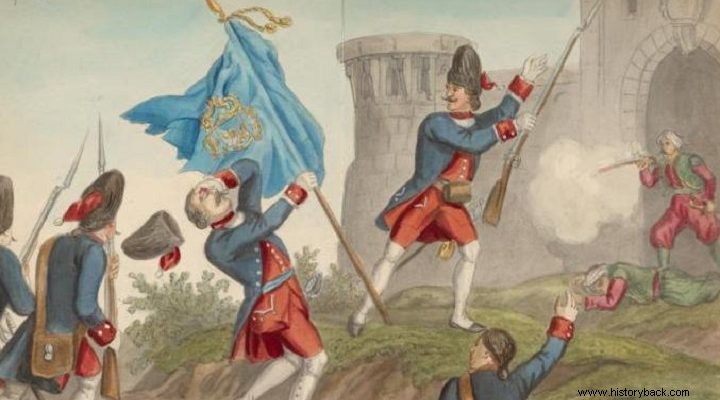
After his initial victories in the Peloponnese, in 1685, Morosini decided to expel the Turks from the entire region. For this purpose, during the winter Venice proceeded to recruit German mercenaries.
He was also hired as commander-in-chief of the land forces in the Peloponnese forces the Swedish-German general Otto von Königsmarck , son of the famous general of the Thirty Years' War.
At the beginning of March 1686 the Seraskeri of Peloponnese moved with 12,500 men towards Mani besieging the fortress of Kelefa . However, the intervention of 4,500 Venetians and 2,000 Maniacs forced the Turks to retreat.
Navarino – Methoni
In the meantime Morosini was reinforced with 1,000 men of the Knights of St. John and 500 of the pope. In the meantime, the new Seraskeri Ismail Pasha had gathered strong forces in Messinia. Morosini hastened thither and the fleet landed 10,000 infantry and 1,000 cavalry near old Navarino.
Soon the Turkish garrison surrendered the castle there with a treaty. The Turks of the new Navarino, however, did not surrender and the Venetian army began to besiege the fortress. In the meantime, Ishmael of Seraskeri appeared with 8,000 infantry and 2,000 horsemen in order to reinforce the besieged.
Königsmark immediately rushed to meet him at the head of 7,000 infantry and 700 cavalry. The experienced general defeated the Turks causing them 500 casualties. After this (June 2, 1686) the besieged surrendered by treaty.
Immediately afterwards the Venetians turned against Methoni. On June 25, after a short siege and heavy Turkish losses, the fortified city in question surrendered . At the same time, Venetian troops occupied Cyparissia.
Nafplio
After these successes the Venetians turned against Nafplio. On July 18 their army landed at the position of Rodi at a distance of 6 km. from Nafplio. Immediately the Venetians occupied the hill of Palamidi which was not fortified at the time.
In Nafplion the garrison consisted of 3,000 Turks under Mustafa Pasha. Mustafa sent a message to the serasker Ismail asking him for help. The latter hastened to the city and on July 20 he encamped near Argos. The same night he reinforced the garrison with 300 janissaries.
In the face of these developments, Morosini and Königsmark decided to place siege guns in Palamidi, while at the same time they took security measures against the serasker forces. On August 4, 1686 the latter attacked with 4,000 cavalry and 3,000 infantry against the Venetian forces. But Königsmark was waiting for him.
The battle was brief with the Turks crashing against the unbroken lines of the German infantry of the Venetian army. When the Turks exhausted their momentum they were attacked by their opponents. Unable to bear it, they fled.
Ismail, after receiving all the Turks from Argos, left the city. In the meantime in Nafplion, the besieged tried to escape, but were repulsed with heavy losses.
On August 17th Seraskeris returned at the head of 10,000 men. the Turks attacked with fanaticism against the Christians whose vanguard consisted of the 1,000 men of the knights of St. John, Dalmatians and papists. This small force fought heroically and withstood the Turkish pressure as long as it took until Königsmark rushed in with reinforcements.
After a three-hour fierce battle, the Turks retreated defeated, with 1,400 dead, compared to 350 Christian dead and wounded. After this battle the besieged Turks in Nafplio surrendered. On August 18, the Venetians entered Nafplio.
After his defeat, the Seraskeris had retired to Aegios, sending forces to guard the Isthmus. However, the morale of the Turks had fallen. This was proven by the revolt of the Turkish soldiers in Karytaina who slaughtered their officers and fled the Peloponnese. Many more episodes would follow until the final end of the said war.
